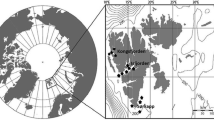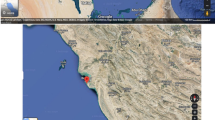Abstract
This paper describes the state of the gonads of Caspian anadromous shad, Alosa kessleri kessleri (Grimm, 1887), migrating for spawning in the Akhtuba River. In May of 2021, the peak of spawning was recorded at a water temperature of 17–18°C. Females and males had gonads at the developing and spawning-capable phases. The fork length (FL) of females averaged 254.1 mm, and their body weight was 178.9 g; for males, this was 209.9 mm and 87.5 g, respectively. Most females were over three years old, while males were between one and three years old. The gonadosomatic index (GSI) in females and males averaged 8.71 and 3.67%, respectively. Among the asynchronously developing secondary growth oocytes in the spawning capable gonads, three different-sized groups were distinguished for intending to spawn the same number of oocyte batches. The number of primary growth oocytes (26.7–59.4% of germ cells on sections) allows for considering these fish as iteroparous. The diameter of the tertiary vitellogenic oocyte was about 800 µm.




Similar content being viewed by others
REFERENCES
Belyaeva, N.V. and Vasil’chenko, O.N., On the maturation of gametes of the blackback shad Alosa kessleri kessleri (Grim) after the construction of the Volgograd dam, Tr. Kasp. Nauchno-Issled. Inst. Rybn. Khoz-va, 1965, vol. 20, pp. 81–84.
Berg, L.S., Ryby presnykh vod SSSR i sopredel’nykh stran (Freshwater Fishes of Soviet Union and Adjacent Countries), Moscow; Leningrad: Akad. Nauk SSSR, 1948, vol. 1.
Blaber, S.J.M., Brewer, D.T., Milton, D.A., et al., The life history of the protandrous tropical shad Tenualosa macrura (Alosinae: Clupeidae): Fishery implications, Estuar. Coast. Shelf Sci., 1999, vol. 49, no. 5, pp. 689–701. https://doi.org/10.1006/ecss.1999.0545
Carscadden, J.E. and Leggett, W.C., Life history variations in populations of American shad, Alosa sapidissima (Wilson), spawning in tributaries of the St John River, New Brunswick, J. Fish. Biol., 1975, vol. 7, no. 5, pp. 595–609. https://doi.org/10.1111/j.1095-8649.1975.tb04633.x
Catalano, M.J. and Allen, M.S., Exploring strategies for gizzard shad removal that account for compensatory density dependence and uncertainty, N. Am. J. Fish. Manag., 2011, vol. 31, no. 6, pp. 1153–1162. https://doi.org/10.1080/02755947.2011.646457
Chmilevskii, D.A., On periods of oogenesis in Teleostei (a review), J. Ichthyol., 2003, vol. 43, no. 4, pp. 296–307.
Chugunova, N.I., Rukovodstvo po izucheniyu vozrasta i rosta ryb (Guide to the Study of the Age and Growth of Fish), Moscow: Akad. Nauk SSSR, 1959.
Dubovskaya, A.V., Histomorphological analysis of the state of the reproductive system of the blackback shad in the period 2013–2017, Mater. III Mezhdunar. nauch.-prakt. konf. “Sovremennaya nauka: perspektivy, dostizheniya i innovatsii” (Proc. 3rd Int. Sci.-Pract. Conf. “Modern Science: Perspectives, Achievements and Innovations”), Astrakhan: Astrakhan. Gos. Univ., 2020, pp. 27–30.
Ganias, K., Divino, J.N., Gherard, K.E., et al., A reappraisal of reproduction in anadromous alewives: Determinate versus indeterminate fecundity, batch size and batch number, Trans. Am. Fish. Soc., 2015, vol. 144, no. 6, pp. 1143–1158. https://doi.org/10.1080/00028487.2015.1073620
Gilligan-Lunda, E.K., Stich, D.S., Mills, K.E., et al., Climate change may cause shifts in growth and instantaneous natural mortality of American shad throughout their native range, Ibid., 2021, vol. 150, no. 3, pp. 407–421. https://doi.org/10.1002/tafs.10299
Glebe, B.D. and Leggett, W.C., Latitudinal differences in energy allocation and use during the freshwater migrations of American shad (Alosa sapidissima) and their life history consequences, Can. J. Fish. Aquat. Sci., 1981, vol. 38, no. 7, pp. 806–820. https://doi.org/10.1139/f81-109
Götting, K.J., Beitrage zur Kenntnis der Grundlagen der Fortpflanzung und zur Fruchtbarkeits-bestimmung bei marinen Teleosteern, Helgoland. Wiss. Meer, 1961, vol. 8, no. 1, pp. 1–41. https://doi.org/10.1007/BF01609945
Grice, H., Patterson, L., Giangiacomo, C., et al., Potential spawning strategy and fecundity of Alabama shad (Alosa alabamae) from the Apalachicola River, Florida, GA J. Sci., 2014, vol. 72, no. 2, pp. 94–102.
Hyle, A.R., McBride, R.S., and Olney, J.E., Determinate versus indeterminate fecundity in American shad, an anadromous clupeid, Trans. Am. Fish. Soc., 2014, vol. 143, no. 3, pp. 618–633. https://doi.org/10.1080/00028487.2013.862178
Ivanov, M.F., Features of the development of egg cells of the Caspian–Volga herring (Caspialosa kessleri and Caspialosa volgensis) and experiments on artificial breeding of the blackback Caspian herring (Caspialosa kessleri) in the Volga delta, Vestn. Leningrad. Gos. Univ., 1953, no. 10, pp. 51–76.
Ivanov, M.F. and Dodzina, F.I., Histological analysis of the gonads of the Volga anadromous herring during migration and spawning, Uch. Zap. Leningrad. Gos. Univ. Ser. Biol. Nauk, 1957, no. 44, no. 228, pp. 155–180.
Katunin, D.N., Bespartochnyi, N.P., and Sapozhnikov, V.V., Comprehensive oceanographic studies of the Caspian Sea during the voyage on the research vessel Issledovatel’ Kaspiya (August–September 1999), Okeanologiya, 2000, no. 1, pp. 156–158.
Kuzishchin, K.V., Gruzdeva, M.A., Filenko, V.A., and Pavlov, D.S., Caspian anadromous shad Alosa kessleri kessleri (Grimm, 1887) from the Akhtuba River, Lower Volga River basin: Biological and morphological features, Inland Water Biol., 2020, vol. 13, no. 1, pp. 79–87. https://doi.org/10.1134/S1995082920010125
Lakin, G.F., Biometriya (Biometrics), Moscow: Vyssh. Shk., 1990.
Leggett, W.C. and Carscadden, J.E., Latitudinal variation in reproductive characteristics of American shad (Alosa sapidissima): Evidence for population specific life history strategies in fish, J. Fish. Res. Board Can., 1978, vol. 35, no. 11, pp. 1469–1478. https://doi.org/10.1139/f78-230
Lepilina, I.N., Voinova, T.V., Nikolenkov, A.A., and Stepanova, T.G., Status of stocks of blackback shad, biological, physiological and biochemical parameters and trophological analysis of spawners migrating to the Volga River, Vestn. Astrakhan. Gos. Tekhn. Univ. Ser. Ryb. Khoz-vo, 2016, no. 2, pp. 43–52.
McBride, R.S., Somarakis, S., Fitzhugh, G.R., et al., Energy acquisition and allocation to egg production in relation to fish reproductive strategies, Fish Fish., 2015, vol. 16, no. 1, pp. 23–57. https://doi.org/10.1111/faf.12043
McBride, R.S., Ferreri, R., Towle, E.K., et al., Yolked oocyte dynamics support agreement between determinate- and indeterminate-method estimates of annual fecundity for a northeastern United States Population of American shad, PLoS One, 2016, vol. 11, no. 10, . Article e0164203. https://doi.org/10.1371/journal.pone.0164203
Mikodina, E.V., Sedova, M.A., Chmilevskii, D.A., et al. Gistologiya dlya ikhtiologov. Opyt i sovety (Histology for Ichthyologists. Experience and Advice), Moscow: VNIRO, 2009.
Mouchlianitis, F.A., Belo, A.F., Vieira, A.R., et al., Primary and secondary oocyte growth dynamics in anadromous semelparous Allis shad Alosa alosa, J. Fish. Biol., 2019, vol. 95, no. 6, pp. 1447–1456. https://doi.org/10.1111/jfb.14161
Mouchlianitis, F.A., Minos, G., and Ganias, K., Timing of oocyte recruitment within the ovulatory cycle of Macedonian shad, Alosa macedonica, a batch spawning fish with indeterminate fecundity, Theriogenology, 2020, vol. 146, pp. 31–38. https://doi.org/10.1016/j.theriogenology.2020.01.050
Mouchlianitis, F.A., Schultz, E.T., Santos, Schmidt, T.C., et al., Ovarian dynamics and fecundity regulation in blueback herring, Alosa aestivalis, from the Connecticut River, US, J. Appl. Ichthyol., 2021, vol. 37, no. 1, pp. 64–72. https://doi.org/10.1111/jai.14128
Murauskas, J.G. and Rulifson, R.A., Reproductive development and related observations during the spawning migration of hickory shad, Trans. Am. Fish. Soc., 2011, vol. 140, no. 4, pp. 1035–1048. https://doi.org/10.1080/00028487.2011.607036
Mylonas, C.C., Zohar, Y., Richardson, B.M., and Minkkinen, S.P., Induced spawning of wild American shad Alosa sapidissima using sustained administration of gonadotropin-releasing hormone analogue (GgnRHa), J. World Aquacult. Soc., 1995, vol. 26, no. 3, pp. 240–251. https://doi.org/10.1111/j.1749-7345.1995.tb00252.x
Nikolaev, V.A., Geological history, relief and alluvial deposits of the Akhtuba River, in Priroda i sel’skoe khozyaistvo Volgo-Akhtubinskoi doliny i del’ty (Nature and Agriculture of the Volga–Akhtuba Valley and Delta), Moscow: Mosk. Gos. Univ., 1962, pp. 11–56.
Olney, J.E., Denny, S.C., and Hoenig, J.M., Criteria for determining maturity stage in female American shad, Alosa sapidissima, and a proposed reproductive cycle, Bull. Fr. Pêche Piscic., 2001, nos. 362–363, pp. 881–901. https://doi.org/10.1051/kmae:2001025
Oven, L.S., Osobennosti oogeneza i kharakter neresta morskikh ryb (Peculiarities of Oogenesis and Nature of Spawning of Marine Fishes), Kiev: Nauk. Dumka, 1976.
Oven, L.S., Spetsifika razvitiya polovykh kletok morskikh ryb v period razmnozheniya kak pokazatel’ tipa neresta i reaktsii na usloviya sredy obitaniya (Specificity of the Development of Germ Cells of Marine Fish During the Breeding Season as an Indicator of the Type of Spawning and Response to Environmental Conditions), Moscow: VNIRO, 2004.
Pina, T., Esteves, E., and Andrade, J.P., Gross and histological observations of ovarian development in twaite shad, Alosa fallax fallax, from the rivers Mira and Guadiana (Portugal), Sci. Mar., 2003, vol. 67, no. 3, pp. 313–322. https://doi.org/10.3989/SCIMAR.2003.67N3313
Pyatikopova, O.V., Modern features of spawning migration of spawners and downstream migration of larvae of blackback herring Alosa kessleri kessleri (Grimm, 1887) in the Volga–Caspian basin, Extended Abstract of Cand. Sci. (Biol.) Dissertation, Astrakhan State Technical University, Astrakhan, 2019.
Roskin, G.I. and Levinson, L.B., Mikroskopicheskaya tekhnika (Microscopic Technique), Moscow: Sov. Nauka, 1957.
Svetovidov, A.N., Fauna SSSR. Ryby, T. 2. Vyp. 1: Sel’devye (Clupeidae) (Fauna of the USSR. Fishes, vol. 2, no. 1: Herrings (Clupeidae)), Moscow: Akad. Nauk SSSR, 1952.
Tanasiichuk, V.S., Spawning of anadromous herring under conditions of regulation of the Volga runoff, Tr. Kasp. Nauchno-Issled. Inst. Rybn. Khoz-va, 1962, vol. 18, pp. 143–166.
Vasil’eva, T.V., Vlasenko, A.D., and Degtyareva, N.G., History and current state of fisheries research in the Caspian, Vopr. Rybolovstva, 2012, vol. 13, no. 4 (52), pp. 679–688.
Vodovskaya, V.V., Reproduction of herring on the Volga, Ryb. Khoz-vo, 1994, no. 6, pp. 28–29.
Vodovskaya, V.V., Influence of the hydrological regime on the reproduction and number of anadromous herrings, Gidrometeorol. Gidrokh. Morei, 1996, vol. 6, no. 2, pp. 304–305.
Vodovskaya, V.V., Ekologicheskie aspekty biologii prokhodnoi sel’di Kaspiya (Ecological Aspects of the Biology of Anadromous Herring in the Caspian), Astrakhan: Kasp. Nauchno-Issled. Inst. Rybn. Khoz-va, 2001.
Voinova, T.V., Current state of the spawning population of the anadromous blackback shad Alosa kessleri kessleri, Ekol. Monitoring i Bioraznoobrazie, 2012, no. 2, pp. 75–78.
Voinova, T.V., Dynamics of catches and biological indicators of blackback shad in the Volga-Caspian fishery subarea under modern conditions (Volga River and its watercourses), Vestn. Astrakhan. Gos. Tekhn. Univ. Ser. Ryb. Khoz-vo, 2013, no. 3, pp. 25–29.
Voinova, T.V., Monitoring of the current state of the population of blackback shad (Alosa kesselri kessleri Grimm) in the Volga River, Ekol. Monitoring i Bioraznoobrazie, 2016, no. 1, pp. 21–25.
Voinova, T.V., On the fecundity of the blackback shad Alosa kessleri kessleri (Grim), Vestn. Astrakhan. Gos. Tekhn. Univ. Ser. Ryb. Khoz-vo, 2021, no. 3, pp. 77–85. https://doi.org/10.24143/2073-5529-2021-3-77-85
Yilmaz, S. and Polat, N., Age determination of shad (Alosa pontica Eichwald, 1838) inhabiting the Black Sea, Turk. J. Zool., 2002, vol. 26, no. 4, pp. 393–398.
ACKNOWLEDGMENTS
The authors express their gratitude to the founder and employees of “Delta Akhtuby”: M.A. Arifullin for comprehensive assistance in the work performance, D.V. Maryshev and A.A. Zolotukhin for active assistance in data collecting in the field.
Funding
The research was carried out within the scientific project of Moscow State University no. 121032300100-5 and the project of Moscow State University “Noah’s Ark” (processing of materials, preparation of summary tables and figures), as well as with the support of the Russian Science Foundation, grant no. 19-14-00015-P (preparation of manuscripts).
Author information
Authors and Affiliations
Corresponding author
Ethics declarations
Conflict of interests. The authors declare that they have no conflicts of interest.
Statement on the welfare of animals. All applicable international, national, and/or institutional guidelines for the care and use of animals were followed.
Rights and permissions
About this article
Cite this article
Zhukova, K.A., Emel’yanova, N.G., Kuzishchin, K.V. et al. Reproductive Condition in the Caspian Anadromous Shad Alosa kessleri kessleri (Alosidae) during Spawning Migration in the Volga River. J. Ichthyol. 63, 762–769 (2023). https://doi.org/10.1134/S0032945223040227
Received:
Revised:
Accepted:
Published:
Issue Date:
DOI: https://doi.org/10.1134/S0032945223040227




